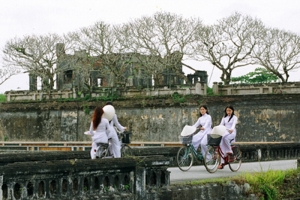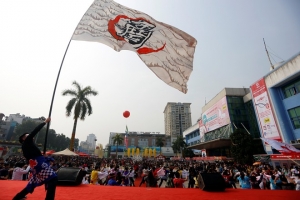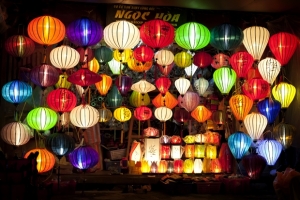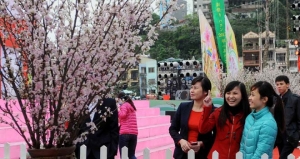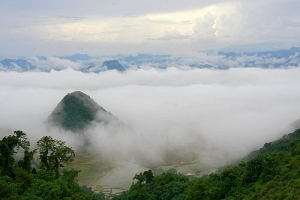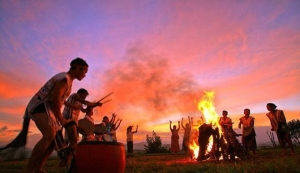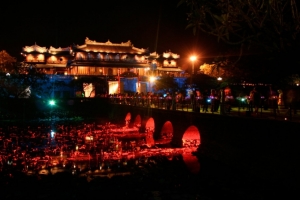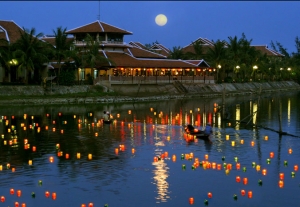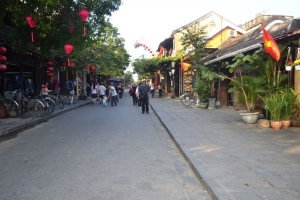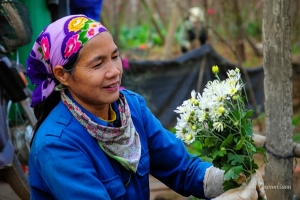
Asia Pacific Travel Team
Thua Thien-Hue welcomes over 2.6 million visitors in 11 months
The tourist sector posted VND2.5 trillion (US$118.4 million) in turnover during the period, a year on year increase of 14.86%.
The figures show that the province’s targets set for 2014 at 2.85 million visitors and VND2.7 trillion (US$128.6 million) of revenue are within reach.
In the coming time, the province will continue to offer more products and services as well as a variety of promotions to attract more tourists.
A Golden Tourism Week will be held from December 24-30 in the Hue relic site with many discount packages.
The provincial Department of Culture, Sports and Tourism is implementing a US$230,000 project on developing sustainable and responsible tourism which is funded by the International Labour Organisation (ILO) and the United Nation’s Education, Science and Culture Organisation (UNESCO).
The project aims to promote the ancient ThanhToan bridge in Thanh Thuy Commune, Huong Thuy district, as a tourist site through developing sight-seeing tours and training locals in service and business skills.

Thanh Toan bridge
At the same time, the locality continues to cooperate with other provinces in the central region on the heritage tour project.
Ake ome! 2015 - Japanese culture festival to welcome New Year 2015
Ministry of Culture, Sports and Tourism has promulgated a decision on the organization of Japanese culture festival to welcome New Year 2015 – Ake ome! 2015. Accordingly, Ake ome! 2015 festival will be organized from 27th to 28th December 2014 in Viet Nam Exhibition Fair Centre (148 Giang Vo Street, Ba Dinh District, Ha Noi) by Viet Nam Exhibition Fair Centre Limited Company and related agencies.
Taking the idea from a Japanese sentence “Akemashite Omedetou” with the meaning of Happy New Year. Ake ome! 2015 festival aims to create a playing ground for young people on the occasion of New Year 2015 and enhance Viet Nam – Japan friendship.
Ake ome! 2015 festival will have commerce – cuisine booths to introduce traditional craft products and delicious foods of Viet Nam and Japan, especially traditional ornaments of Japanese on the occasion of New Year including Kadomatsu made of pine and bamboo, representing longevity and health; or Koinobori - carp shaped lantern, a symbol of bravery, steadfastness and ambition.
In the festival, visitors can also participate in some cultural activities to welcome New Year in Japan such as omikuji (drawing lots in New Year), buying omamori luck charms and Daruma traditional dolls, trying Yukata costume (summer kimono) of Japan... In particular, young people will have the opportunity to wallow in Yosakoi Japanese traditional dance or participate in colorful fashion and cosplay shows.
Thu Giang
The 1st Hoi An - Gwangju handicraft and Fine Arts exchange 2014
Co-organized by Hoi An city and Gwangju city, Korea on the occasion of the 15th anniversary of the UNESCO-World cultural heritage of Hội An Ancient Town (04/12/1999-2014).
The event aims to build up the friendly relationship as well as the cooperation on culture – art, fine arts and crafts between Hoi An city and Gwangju city, Korea. It will also help to promote the traditional handicraft of the two cities to all the visitors.
There will be various activities such as craft products display (lanterns, Thanh Ha potteries, Kim Bong furnitures, sycamore hammocks, Quang Nam silk and products made from bamboo or coconut leaves,..) and craft presentation.
The craftmen from Gwangju, Korea will bring here their traditional crafts such as weaving, papermaking, bamboo art.. Along with it, the traditional art performance will be held every evening during the event by Hội An city. Meanwhile, the photo exhibition will take place at the same venue.
On the occasion, Hoi An city in cooperation with the International Labor Organization (ILO) and Korean craftmen will hold a talk “The development of handicraft and fine arts in Hoi An and Gwangju” taking place at 14:00 on Dec 2nd, 2014.
This program will contribute to the introduction and promotion of cultural professions and traditional handicraft products in Hoi An and Gwangji cities to domestic and foreign tourists.
The 3rd Sakura Festival to be opened in Quang Ninh
Remarkably, many sakura branches from the area that was ruined by the tsunami will be displayed at the festival as a thank to all the Vietnamese in general and Quang Ninh people in particulary for their support for Japan during their hard time.
Furthermore, the festival draws the participation of 40 goods booths introducing the products of the two provinces. Also, there will be a gastronomy exchange program and an art show performed by famous trouples of Quang Ninh and Japan.
Lung Van - The valley of clouds
Located at an altitude of 1,200m above sea level, Lung Van in Tan Lac District looks like a fairyland amidst white clouds so it has another name, the Cloud Valley. Lung Van is considered “The Roof of Muong Bi,” one of the four major and the most ancient cultural cradles of the Muong ethnics in Hoa Binh Province, including Muong Bi, Muong Vang, Muong Thang and Muong Dong.

According to the “Land and Water” epic of the Muong ethnic people in Hoa Binh, Lung Van was once a peaceful village which was then completely destroyed by a devastating flood and no one survived after the flood except for a couple who was saved by being stuck in a giant tree, called Bi. The tree had deep roots in 9 rivers and ten mountains so it was not swept away. Having no place to live, the couple built a tent under the tree to live and they reclaimed new land for farming, tamed wild animals for raising, made containers to get water and then established a hamlet and named it after the tree to show their gratitude to the tree that saved their lives. The present-day Muong Bi is a vast mountainous area of many communes in Tan Lac District and Lung Van is the highest place where the Muong ethnic people are living and it is believed to be the place where the Bi tree grew.

Lung Van is now still unfamiliar to many people because it is surrounded by deep blue mountains and is very far from the main road. It has still kept intact many traditional cultural and architectural features, such as tortoise-shaped roofs and Muong women’s dresses which are black and decorated with colourful patterns. Today their dresses are made shorter, suitable for working, however all delicate patterns remain unchanged.
This land is related to many fairy tales and is called the land of longevity because there are many people more than 100 years old who are still healthy. At the age of 90-100, they still work to help their grandchildren. It is believed that the locals’ longevity is due to the water from streams in the region, their good and simple lifestyle and airy and pure atmosphere.
In his notes about culture of Muong areas, culturist Phan Cam Thuong emphasised the difficulties in travelling to the region and the locals’ self-sufficient life. The locals go to their market for entertainment and sometimes exchange their products, such as brocade, woven products, fruit and vegetables. The locals have little money and some have no money.
Lung Van is most beautiful after Tet, from February to April, because at that time it is covered by white clouds. It is also the time the Muong people prepare for a new crop on terraced fields - “A Giant Mirror of Muong Bi”. So far, they have maintained their traditional farming method. Ha Van Binh, an elder in Lung Van said: “We live rather separately so the method of growing rice is quite different from those who live in lower areas. We only start the crop when it rains and the terraced fields are submerged in ‘heaven’s water’. We sow rice by hand that results in low productivity, but is famous for its high quality and delicious taste. Therefore, in the past rice made in Lung Van was used as an offering to hamlet lords, so it is also called ‘the rice of the hamlet lord’.”
With a pure atmosphere, spectacular scenery and peaceful life, Lung Van is really an ideal place for those who want to escape the noisy urban life and discover the unique cultural features of the Muong ethnic people.
Opening national fine arts photo exhibition 2014 in Da Lat city
The event is showing 96 photos featuring the Central Highlands’ beauty and 105 photos under different themes, were selected from 6,718 entries (1,430 about the Central Highlands and 5,288 under other themes) by 1,046 amateur and professional photographers nationwide.
The photos are assessed as valuable works both spiritually and artistically, truly and vividly depicting current events, human beauty, customs, culture, landscapes, national construction and defence, as well as the landscapes of the Central Highlands region.
Fine Arts Council has established by the Ministry of Culture, Sports and Tourism presentedprizes for 26 outstanding works, with 13 prizes for each topic. Two gold medals went to ‘Hoa khuc’ (Chord) by Tran Thi Minh Ha from Ho Chi Minh City in the category for the Central Highlands region and ‘Xuat phat’ (Start) by Phung Duc Dung from Da Nang city in the open theme category. Four silver and six bronze medals and 14 consolation prizes were awarded to other outstanding photos.
The exhibition will run until December 2.
Hue - An ancient beauty of Vietnam
In addition to dropping by some must-see destinations such as Hue Royal Citadel, Thien Mu Pagoda and the royal tombs of Nguyen Dynasty’s kings, tourists can stroll along the streets close to the Huong River to admire Hue’s beauty in the evening. The liveliest place that should be named is the Truong Tien Bridge area where there is a busy night market full of people checking in and out and at the same time watching the bridge’s lights changing their colors.
.jpg)
Truong Tien Bridge
To Hue’s citizens, the Truong Tien Bridge on the Huong River has witnessed all the ups and downs of history and become a romantic symbol of the ancient capital. During the day, the bridge manifests varied beauties with simplicity early in the morning, hustle and bustle in the daytime, solitude at twilight and hectic at night when its colorful lights are reflected on the water. The road beneath the bridge is a busy night market where a variety of goods are sold such as foods and souvenirs.

A visit to Hue will be incomplete without taking a dragon boat ride in the Huong River at night and listening to Hue’s royal court music. A trip en route from the Truong Tien Bridge to the Phu Xuan Bridge by boat will cost only VND10,000-15,000 a person while the trip plus Hue’s music performance will cost VND50,000 a person. In the evening tourists will listen to some ladies in purple traditional ao dai singing beautifully. This is a completely different Hue.
Visitors can take a sightseeing tour by motorbike along the roads leading to the north, south, east and west gates. These roads under the shade of seasoned trees are full of street vendors and restaurants selling Hue’s signature dishes such as banh beo, banh nam, banh loc, Hue-style sweetened soup and Hue-style noodle soup. Hue represents a combination between old and new elements.
Hoi An provides 2000 more rooms for visitors in 2020
Hoi An had 203 accommodations with a total of 4,967 rooms as of June 30, including 1,898 at four-star and five-star standards, and 956 three-star rooms. Thousands of rooms are being built, increasing the number of rooms in the city to 6,393 in 2015.
The city is expected to provide 8,046 rooms to serve more than three millions tourists per year by 2020.
The Hoi An People’s Commitee encourages the development of villas, garden houses and homestays to preserve the nature and landscapes of villages and allows the building of hotels meeting two-star and three-star standards with under 50 rooms.
The city will also establish Cua Dai tourism clusters in Cam Thanh, Cam An, Cam Chau and Cam Pho wards.
The increase of rooms contributes to developing more competitive establishments, which will promote the development of the city’s commercial services and tourism.
Quang Nam - The land of “Water convergence –People convergence – Culture convergence”
Let’s visit this destination once to discover and be proud of the land of Culture, Competition - examinations and Extraordinary persons.
Quang Nam new land’s residents, the first Vietnamese came into contact with Western culture through Catholic missionaries, businesspersons, and then with the Chinese, the Japanese by Hoi An trading port. The exchanges with different cultures have remained the various dark and light stamps in social activities which have expressed in the popular cultural structure.
When coming to Quang Nam, tourists will enjoy interesting experiences on the way of living, friendly attitudes and simple life of local residents. Visitors will also live in the ancient and mild space of Hoi An ancient town that was selected “the most popular city in the world in 2012” by Wanderlust Travel magazine.

Hoi An ancient town
Hoi An city has attracted tourists by its ancient figures of side by side small and moss houses. Entering the ancient quarter, tourists would be at fault in an isolated world which has been separated from the destruction of time. There is neither any noise of engines nor shops being shined by bright colourful lights. All those things are just the past. Its time and space have been engraved in the ancient wooden house, in the Japanese bridge, two-storey wooden houses standing beside the Hoai river banks which are silently existing for human’s thinking of a time of the past.

My Son Sanctuary
Coming to My Son Sanctuary Site, which was recognized as a World Cultural Heritage by UNESCO in 1999, the tourists can contemplate the mystical and fanciful beauty of its monuments. Many towers are decorated with genie statues and beautiful patterns. This World Cultural Heritage’s construction was under the India’s architectural influence. A sanctuary, the first place of worship at My Son which was built in the 4th century, is still remained overhere. King Bhadrésvara founded the first Champa dynasty in Amaravati region in the late of the 4th century. After passing away, he has been worshipped at My Son The main tower is the holy place to worship the Linga and Shiva statues. The Shiva God was “the King‘s protection”.
My Son is known as a beautiful cultural treasure of the ancient Cham people and a lively architectural museum of the aesthetics of humanity. Despite ravages of war and time, My Son Sanctuary stands as a witness to the history of the ancient Champa, and is an important part of the world’s cultural heritages.

Phu Ninh lake
Located about 7km from Tam Ky city center is the Phu Ninh lake. Looking down from a hill, the lake looks like a young girl lying across a green land zone of Quang Nam. Phu Ninh makes tourists amorous by its scenery like a watercolor painting. This lake is valued as a paradise for anyone who wants to the urban noise peace. There are about 30 islets in the lake. Tourists can visit them and the whole lake by canoes.

Bang An temple
Quang Nam province has restored hundreds of Vietnamese old architectural constructions such as houses, temples, pagodas, communal houses which were built from 300-500 years ago. The values of those relics are not only in their cultural and artistic characters, but also in their important historical meanings which have expressed the long development of a cultural region of the Dang Trong. The ancient Champa Tra Kieu capital, Khuong My, Chien Dan, Bang An temples, Dong Duong Buddhist Institute are the places which have engraved the bright stamps of the Sa Huynh, Champa, Dai Viet civilizations.

A bamboo weaving village in Quang Nam
The cultural values of Quang Nam province are not only showed in its ancient architectural constructions but also in unique cultural figures of customs, habits and traditional festivals. All traditional festivals of Quang Nam bring spiritual and religious facts. They are held every year to wish good weather, calm sea, peace for country, to praise the ancestors, look back their family source, national tradition and give expression to the aspiration for the True, the Good and the Beautiful. Quang Nam is also a place where the traditional craft villages have been established and developed since hundreds or thousands of years. With many changes of the country, those craft villages have still existed and developed as an undetachable part of their history.

Quang noodle
In addition, Quang Nam’s famous dishes such as My Quang (Quang Noodle), Cao lau, Be thui (barbacued veal), Banh trang thit heo (Flat rice pancake with pork and vegetable), Bánh vac (White rose), Banh to (glutinous rice cake) have created a very private figure of Quang Nam cuisine. Quang Nam foods are simple in cooking but moreish in quality. Quang Noodle is a familiar dish of the Vietnamese in many places including foreign tourists.
When talking about Quang Nam cultural sub-region, we have to mention its folk art treasure of Ve Quang and Ho (Vietnamese folk melody) such as Ho di cay, Ho xay lua, Ho Tat Nuoc, Ho Gia Gao, Ho Gia Voi, Ho Dạp xe Nuoc, Ho Khoan, Ho Ba Ly, Hat Ba Trao, Hat Nhan Ngai, Bai Choi which are performed with Quang Nam’s dialect and charming voice…
Let’s visit to Quang Nam once to discover the beauty of a Vietnam Central province - the land of “Water convergence –People convergence – Culture convergence”.
Ha Noi in the Ox-eye daisies flower season
These days, Hanoi’s famous flower villages such as Nhat Tan and Tay Tuu are filled with the scented wafts of ox-eye daisies in full bloom and the beautiful sight of their yellow to brownish centres with showy white petals.
Farmers harvesting daisies have to wake up early to sell them at the market.
Each bunch of daisies cost from VND20,000 to VND40,000.
The name ‘daisy’ originates from Anglo Saxon ‘day's eyes’ which refers to the opening and closing of the flower throughout the cycle of night and day.




